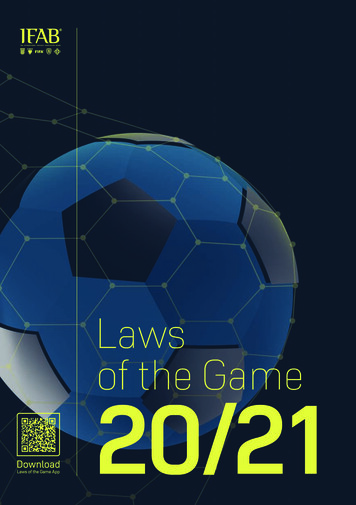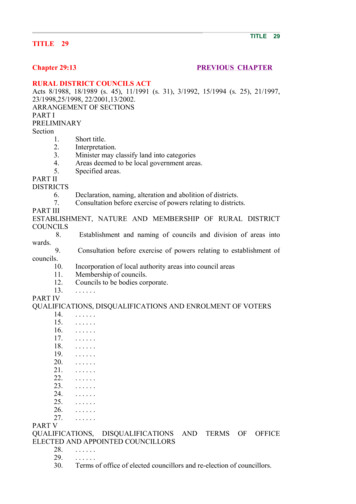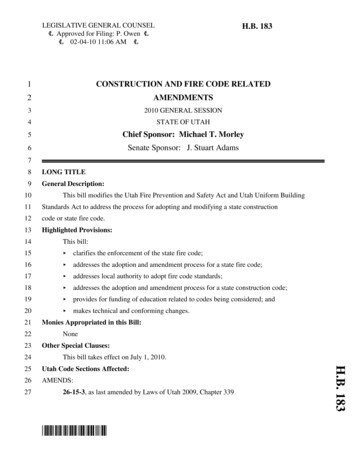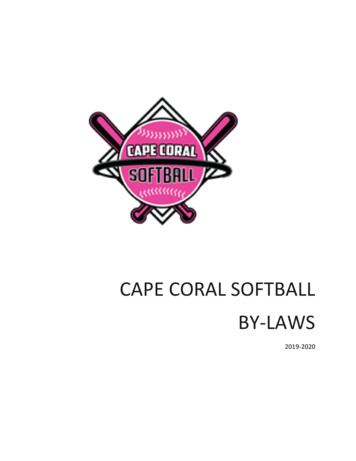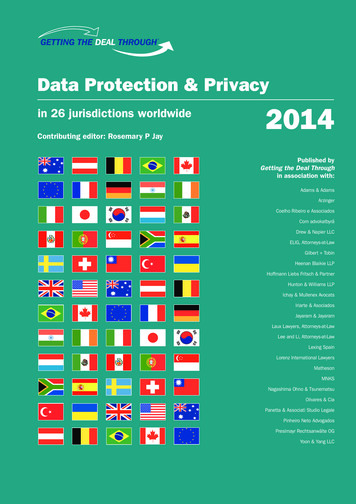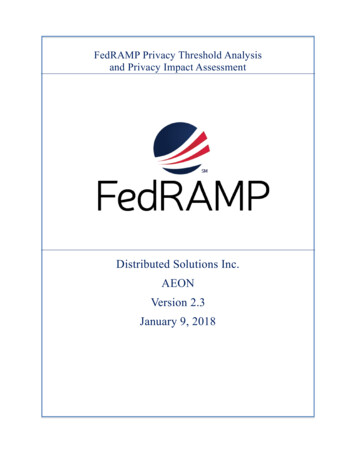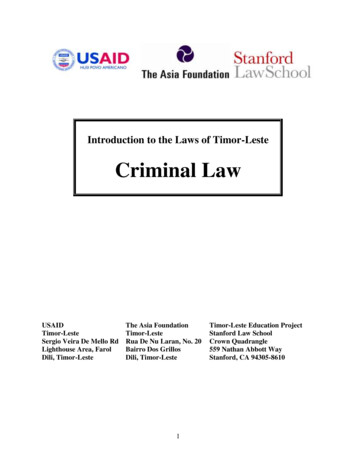
Transcription
Introduction to the Laws of Timor-LesteCriminal LawUSAIDTimor-LesteSergio Veira De Mello RdLighthouse Area, FarolDili, Timor-LesteThe Asia FoundationTimor-LesteRua De Nu Laran, No. 20Bairro Dos GrillosDili, Timor-Leste1Timor-Leste Education ProjectStanford Law SchoolCrown Quadrangle559 Nathan Abbott WayStanford, CA 94305-8610
TABLE OF CONTENTSPREFACE TO THE SERIES. 3CRIMINAL LAW . 5I.Concepts of Criminal Law . 61. Introduction and Layout of the Chapter . 62. General Concepts and Goals of the Penal Code . 6General Concepts of the Penal Code . 7The Constitution and Criminal Law . 8Public and Semi-Public Crimes . 93. Elements of a Crime. 10Omission versus Commission . 10Intent Requirement. 114. Summary . 16II.Penalties and Liability. 181. Penalties . 182. Liability . 22Forms of Crimes . 23Perpetrators . 25Exclusion of Unlawfulness or Guilt . 263. Summary . 30III.Specific Crimes . 321. Crimes against Peace and Humanity. 342. Crimes Against Persons . 34Killing . 34Crimes Against Physical Integrity . 35Crimes Against Liberty . 36Sex Crimes . 373. Crimes Against Democratic Practice . 344. Crimes Against Assets . 345. Titles V-VIII . 406. Summary . 44IV.Review . 46GLOSSARY . 462
Preface to the Series: Introduction to the Laws of Timor-LesteTimor-Leste has enjoyed a decade of formal independence. The country’s democratic institutionshave grown during this period. But, as thoughtful Timorese are quick to point out, much remainsto be done. Building viable and professional state institutions takes time. And growing thehuman resource capacity within those institutions is always a major challenge to new states.The capacity building imperative in Timor-Leste is both striking and compelling. Establishingstate agencies in the first instance is relatively much easier than filling those agencies witheffective professionals that uphold their duties and responsibilities. Building the capacity of apool of Timorese who hold, or may hold, positions within legal and other state institutions iscrucial. Likewise, building an educated understanding and awareness of the obligations andresponsibilities of key actors within legal institutions, and government institutions more broadly,contributes to setting demands and expectations for performance among the polity. Encouragingprofessionalized capacity within state institutions, on the one hand, and thoughtful and calibrateddemands for performance by citizens, on the other hand, are essential dynamics for thedevelopment of the rule of law and a democratic state in Timor-Leste. Institutions of higherlearning, such as universities and professional training centers, can and should play a key role instimulating and sustaining this dynamic. Indeed, education is foundational.This paper is part of the Introduction to the Laws of Timor-Leste series of papers produced by theTimor-Leste Legal Education Project (TLLEP). This series seeks to critically engage the readerin thinking about the laws and legal institutions of Timor-Leste, and is based on a model ofeducational writing first introduced in TLLEP’s Introduction to Professional Responsibility inTimor-Leste textbook, published in 2011. Founded in March of 2010, TLLEP is a partnershipbetween The Asia Foundation and Stanford Law School. Working with local actors in the Timorlegal sector, the project’s goal is to positively contribute to the development of domestic legaleducation and training in Timor-Leste. USAID provided funding for this series through itsTimor-Leste Access to Justice Program.The authors of the legal working papers focused on writing in clear, concise prose, and on usinghypothetical legal situations, discussion questions, and current events. Through this style ofwriting and pedagogy, the aim is to make these texts accessible to the largest possible audience.The texts are designed to be broadly accessible to experienced Timorese lawyers and judges,government officials, members of civil society, Timorese students in law, and the internationalcommunity. They cover topics ranging from constitutional law to inheritance law to thePetroleum Fund Law.These working papers represent the dedicated efforts of many individuals. Stanford Law Schoolstudents authored the texts and subjected each working paper to an extensive editing process.The primary authors for this series were Peter Broderick, Daniel Cassman, Margaret Hagan,Brian Hoffman, Lexi Shechtel, and Anne Johnson Veldhuis, all Class of 2013, Jessica Fox,Hamida Owusu, and Samuel Saunders (all Class of 2014) edited the series under the guidance ofStanford Rule of Law Fellow Megan Karsh (’09). The students benefitted from the substantialand extensive guidance provided by Brazilian lawyer Dennys Antonialli (LLM ‘11) andGeoffrey Swenson (‘09), TLLEP’s former in-country director and legal advisor to the AsiaFoundation’s Dili office.3
The program has also received extensive support from Kerry Brogan, previous CountryRepresentative Silas Everett, current Country Representative Susan Marx, Juliao de DeusFatima, and a host of other Asia Foundation staff. USAID Timor-Leste provided vital financialand programmatic support to the program. We especially thank USAID Director Rick Scott andUSAID staff Ana Guterres and Peter Cloutier. The US Embassy in Dili, especially AmbassadorHans Klemm and Ambassador Judith Fergin, have been incredibly supportive. I would be remissif I did not thank the former and current deans of Stanford Law School, Deans Larry Kramer andLiz Magill, for their unwavering support of this project.Finally, this series of papers simply would not have been possible without the many thoughtfuland critical insights from Timorese judges, educators and lawyers, and those who work withinTimorese institutions. Prosecutor General Ana Pessoa, Public Defender General Sergio de JesusHornai, and President of Court of Appeals Cláudio Ximenes were extremely gracious inclarifying issues related to their respective organizations and offering constructive suggestions.The textbooks received vital input from National University of Timor-Leste (UNTL) faculty andstaff throughout the drafting and review process including comments from Rector AurelioGuterres, Law Deans Tome Xavier Geronimo and Maria Angela Carrascalão, ProfessorBenjamin Corte Real, and Vasco da Cruz of the Portuguese Corporation. Feedback from UNTLstudents themselves on draft text was immensely helpful for the final text. The Judicial TrainingCenter (CFJ) has also been a source of wisdom throughout the drafting process, particularly CFJDirector Marcelina Tilman, Erika Macedo, and Bernardo Fernandes. The text benefited as wellfrom the contributions of Charlie Scheiner and La’o Hamutuk, the staff of the Ministry of JusticeLegislation Unit, AALT Executive Director Maria Veronika, Judge Maria Netercia, JudgeJacinta Coreia, JSMP Executive Director, Luis de Oliveira, JSMP Legal Research UnitCoordinator, Roberto da Costa, ECM director Lino Lopes, and Sahe Da Siliva. We are alsograteful to Gualdinho da Silva, President of the National Petroleum Authority, for twowonderfully engaging meetings.In addition to this series and the already-published texts on professional responsibility,constitutional rights, and contracts, TLLEP has plans to complete the first edition of a newtextbook in 2013 entitled An Introduction to Criminal Law in Timor-Leste. All texts are updatedas the legal landscape changes. The most recent versions of all published texts are alwaysavailable for download online free of charge on TLLEP’s website: www.tllep.law.stanford.edu.To the students, educators, legal and government professionals that use this book, we sincerelyhope that it sparks study and debate about the future of Timor-Leste and the vital rolemagistrates, prosecutors, public defenders, private lawyers, and government officials will play inensuring the country’s future is bright.Erik JensenProfessor of the Practice of LawCo-DirectorStanford Rule of Law ProgramStanford Law SchoolPalo Alto, California4
Criminal LawCHAPTER OBJECTIVES To explore the general concepts that underlie the Penal Code. To understand the notions of the act and intent requirements for crimes. To examine how penalties are set for persons convicted of crimes. To discuss some of the crimes defined in the Penal Code.Chapter Overview The Timorese criminal justice system is based on the ideas of legality, culpability, andhumanity. Every crime has both a mental state requirement and an act requirement. Crimes defined in the Penal Code generally require criminal intent, unless the Codespecifies that only negligence is required. The act requirement may be either a commission or an omission. The goal of a criminal sanction is to protect society and re-socialize the offender. Crimes are punishable by a variety of penalties, including fine, imprisonment, communityservice, and admonishment. The Penal Code provides for several forms of crimes, including preparatory acts,voluntary desistence, attempt, and remorse. Each is punished differently. The Penal Code provides for various types of perpetrators, including principals,instigators, and accomplices. Each is punished differently. The Penal Code creates several circumstances that exclude unlawfulness, includinglegitimate defense and state justifying need.5
I. CONCEPTS OF CRIMINAL LAWSECTION OBJECTIVES To understand the general concepts behind the Penal Code. To recognize the difference between crimes of omission and crimes of commission. To explore the act and intent elements of crimes.1. Introduction and Layout of the ChapterThe Penal Code of the Democratic Republic of Timor-Leste governs crime andpunishment in Timor-Leste. It defines which actions are illegal and punishable by the state. Itlists which punishments may be imposed and determines how harsh those penalties should be. Italso describes many of the important concepts that underlie criminal law in Timor-Leste. ThePenal Code is, therefore, the primary resource document for this chapter, and we encourage youread the Code in its entirety.This chapter begins by exploring many of the fundamental concepts of the Penal Code,including ideas such as commission versus omission and intent. The chapter then examines thetypes of crimes and criminal liability as defined by the Penal Code. It proceeds to outline thetypes and levels of penalties allowed in Timor-Leste and analyzes how penalties are determined.Finally, it discusses a few of the more common crimes defined in the Penal Code.2. General Concepts and Goals of the Penal CodePut simply, criminal law is the body of law dealing with crimes. Criminal law deals withactions that the law has prohibited. It differs from other types of law because criminal cases arefiled, investigated, and prosecuted by the state. Perhaps the closest analogy in civil law is tortlaw, which also deals with actions that the law says are wrong. But torts are civil, rather thancriminal, wrongs. The government does not prosecute a tort; instead a victim of a tort must file alawsuit in court and prove the charges him or herself (possibly with the help of a lawyer likeyou!). The types of remedies available are also different; torts are generally resolved with theperpetrator paying money to the victim. While some criminal punishments do include monetary6
restitution to the victim, crimes most often result in imprisonment or a fine paid to the state,rather than the victim.All of the crimes and their punishments are defined in the Penal Code of the DemocraticRepublic of Timor-Leste. A commission of Timorese and international legal experts wrote theinitial draft of the Penal Code. The Code was then presented to the National Parliament, whichmade some changes after parliamentary debate and a broad public discussion. Finally, the Codewas approved by the Parliament and the Council of Ministers. It entered into force in 2009.General Concepts of the Penal CodeThe Penal Code is based on a few important concepts that will help you understand howcriminal laws are made and applied. Most broadly, the Penal Code is premised on the idea thatthe government should interfere with people’s freedoms as little as possible:Penal Code of the Democratic Republic of Timor LesteAnnexAs this code is based on the Democratic Rule of Law, the General Part enshrines the principle ofhuman dignity, respect for individual freedoms of each citizen and the responsibility of the Stateto intervene only when unsupportable harm to legal interests fundamental to life in society areobserved. In such events, the State assumes the right to mete punishment and the social duty toreintegrate the offender into society.The law says that the state will only punish someone for “unsupportable harm to legal interestsfundamental to life in society.” That is quite an extraordinary statement, and it is one that reflectsthe Penal Code’s dedication to democracy and the rule of law.This general limitation on the government’s power to prosecute and punish crimes isreflected by the three principles that guide criminal law in Timor-Leste. The three principles arelegality, culpability, and humanity. We describe these ideas briefly here, but they are discussedin more detail in the Annex to the Penal Code.Three Principles of the Rule of Law in the Penal CodeLegality7
The principle of legality states that an act or omission may only be considered a crime (andpunished as a crime) when provided by law. This means that the government may not punishanyone arbitrarily. Only if his or her behavior is outlawed by a provision of the Penal Code maysomeone be punished for a crime.HumanityThe principle of humanity emphasizes the value of each human life. This principle is outlined inSections 29 and 32 of the Constitution. As applied to criminal law, it means that the criminaljustice process will focus on rehabilitating offenders and helping them become productivemembers of society, rather than simply punishing them in perpetuity. To that end, Timor-Lestedoes not allow anyone to be punished by death or life in prison.CulpabilityCulpability is the idea that there can be no penalty without guilt. This means that the harshness ofa penalty can never exceed the measure of guilt. It also means that some people in certainsituations—for example someone with a psychological disorder that prevents him fromdetermining right from wrong—may have reduced criminal liability because their actions lackculpability.These principles will appear consistently throughout our discussion of criminal law.Again, the most obvious example of the principle of humanity is that Timor-Leste does not allowpeople to be executed for crimes, or even sentenced to life in prison. Both the principles ofculpability and humanity are clearly reflected in the law’s general preference for penalties that donot deprive people of their liberty through imprisonment (we will discuss this in more detail inthe section on penalties below).The Constitution and Criminal LawSection 31 of the Constitution provides several protections for convicted criminals andfor persons accused of crimes. These restrictions include limitations on the government’s powerto try people for crimes. For example, the State cannot accuse a person of a crime for an act thatwas not a criminal offence at the time it was committed. Penalties may not be imposed unlessthey are provided for in existing law (an example of the principal of legality, discussed above). Aperson may not be tried and convicted for the same crime more than once. And persons unjustlyconvicted and later exonerated are entitled to fair compensation.Section 24 of the Constitution also provides for a number of protections during criminalproceedings. A person charged with a crime is presumed innocent until convicted. Accusedpersons have the right to a lawyer at all stages of the criminal proceedings against them.8
Everyone has the right to a hearing and the right to present a defense. Evidence obtained bytorture, coercion, or wrongful interference with private life may not be presented against theaccused.Provisions protecting people who have been convicted of crimes can also be found in thesections 30 to 32 of the Constitution. Convicted criminals retain their fundamental rights, exceptfor those necessarily limited by enforcement of the penalty imposed upon them. And sentencesof death or life in prison are expressly forbidden by the Constitution, as is any form of cruel,inhuman, or degrading treatment. A more involved discussion of these constitutional provisionsis beyond the scope of this chapter, but it is crucial to mention these protections as they form thefoundation of the criminal justice system in Timor-Leste.Public and Semi-Public CrimesThe Penal Code defines two different types of crimes: public crimes and semi-publiccrimes. The difference between public and semi-public crimes depends on whether a complaintmust be filed in order for the government to prosecute the crime. A complaint is a legaldocument, often filed by the victim of a crime, which claims that a criminal wrong has beencommitted. If a crime is a semi-public crime, its description in the Penal Code will state thatprosecution depends upon the filing of a complaint. Comparatively, public crimes do not requirea complaint in order for the State to prosecute. This is because public crimes are more severethan semi-public crimes. Several examples of public and semi-public crimes are listed below.Examples of public crimes- Treason (Article 196)- Manslaughter (Article 140)- Homicide (Article 138)- Serious offences against physical integrity (Article 146)- Serious coercion (Article 159)Examples of semi-public crimes- Simple offences against physical integrity (Article 145)- Threats (Article 157)- Coercion (Article 158)- Sexual exhibitionism (Article 181)9
3. Elements of a CrimeDetermining when someone is guilty of a crime is a primary goal of criminal law.Unfortunately, the determination of guilt is sometimes extremely difficult. Even deciding whichactions should be criminalized, and which people involved in a crime should be punished, can becomplicated. There is a general requirement that most crimes include both an objective element(actus reus) and a mental element (mens rea). That is, for something to be considered a crime, itmust include both an act that has criminal consequences and a mental state on the part of thecriminal that makes him liable for that crime. A mere accident, without any intention or due tocarelessness, does not constitute a crime. Nor does just thinking about committing a crime,constitute criminal conduct without any action.Omission versus CommissionOne of the key distinctions of actus reus is the difference between omission andcommission. Commission refers to the doing of an act, like firing a gun or breaking into a house.Omission is the opposite; it means refraining from doing something. This might seem to conflictwith the requirement that every crime include an objective act. Indeed, most crimes are crimes ofcommission. For example, killing someone with a gun or a knife is homicide, often a crime ofcommission. But what if a father were to abandon his child, letting the child starve to death? Thefather has not killed the child in the same way that a shooter has killed his victim, but mostpeople would probably say that he is still responsible for the child’s death. Indeed, the PenalCode creates two different crimes for these situations: abandonment (Article 143) describes thefather who lets his child starve, while homicide (Article 138) describes the man who shoots andkills another person. Reflecting the differences in the directness of each criminal’s level ofresponsibility for the victim’s death, abandonment is punished less severely than homicide.Below are several examples of crimes of omission and crimes of commission from the PenalCode:Crimes of Commission and Crimes of OmissionCrimes of Commission- Homicide (Article 138)- Threats (Article 157)- Kidnapping (Article 160)10
- Larceny (Article 251)Crimes of Omissions- Abandonment (Article 143)- Negligent mismanagement (Article 275)- Failure to report (Article 286)- Refusal to cooperate (Article 300)Reviewing this list of crimes of commission and crimes of omission suggests a principlewe might use to distinguish them: crimes of commission involve doing something that the lawsays is wrong, while crimes of omission involve failing to fulfill a duty that the law has created.When we are responsible for the life of another, such as a parent for a child, or someone whocares for someone who is seriously ill, we owe a duty to that person. If the parent or caretakerfails to fulfill that duty and the result is serious harm to the person who needs his care, hecommits a crime. Indeed it is this failure to fulfill one’s duty that constitutes the objectiveelement of crimes of omission.Intent RequirementThe requirement that every crime have a mental element is laid out explicitly in the PenalCode. In fact, the Penal Code requires that in order for criminal liability to attach, the accusedmust act with intent or negligence:Penal Code of the Democratic Republic of Timor-LesteArticle 14: Intent and NegligenceOnly acts committed with intent, or, in cases specifically prescribed in law, with negligence, arepunishable.The Code also provides definitions for intent and negligence:Penal Code of the Democratic Republic of Timor-LesteArticle 15: Definitions of Intent11
1. Any person who commits an act with the intention to do so, and said act is defined as a crime,acts with intent.2. Furthermore, any person who commits an act that constitutes a defined crime as the necessaryconsequence of his or her conduct, acts with intent.3. Whenever an act that constitutes a defined crime is committed as a possible consequence ofthe conduct of a perpetrator, and the perpetrator acts while accepting said possibility, he or sheacts with intent.Article 16: Definitions of Negligence1. Any person who fails to proceed with caution to which, according to the circumstances, thesame is obliged and capable of proceeding, acts with negligence, if the perpetrator:a) Acts in such a manner that commission of a defined crime is a possibility, yet actswithout accepting said result; orb) Does not even realize the possibility of committing said act.2. The type of negligence referred to in the preceding subarticle shall take on the form of grossnegligence whenever circumstances reveal that the perpetrator acted with levity or temerity andfailed to observe elementary duties of prudence required in such a case.The implications of these definitions are quite important for our discussion of criminallaw. Article 14 establishes that, by default, any crime requires intent. For someone to becriminally liable, he must intend to do the crime for which he is accused. Thus, if someone diesin an accident, no homicide has occurred because there was no intent to kill anyone. However, ifthe definition of a crime specifies that only negligence is required, then something less thanintent is required. So if someone involved in the accident caused the accident by failing toproceed with caution, that person might be guilty of manslaughter. For example, if someone isdriving down Avenida de Portugal at 100 kilometers per hour and hits a pedestrian, the driver’saction could be described as criminal negligence (more accurately, this might be consideredrecklessness, see below). If the victim dies, the driver could be convicted of manslaughter. Thisis because while homicide (Article 138) requires intent, manslaughter (Article 140) requires onlynegligence. Note also the definition of gross negligence from Article 16. Gross negligence isespecially severe negligence; driving only 15 kilometers over the speed limit may be negligent,12
but it would likely not be considered gross negligence. Consider the definitions of homicide andmanslaughter from the Penal Code:Penal Code of the Democratic Republic of Timor-LesteArticle 138: HomicideAny person who kills another person is punishable with 8 to 20 years imprisonment.Article 140: Manslaughter1. Any person who, by negligence, kills another person is punishable with up to 4 yearsimprisonment or a penalty of fine.2. In cases where the perpetrator has acted with gross negligence, the same is punishable with upto 5 years imprisonment.Understanding intent elements is crucial to comprehending criminal law. The Penal Codeusually requires intent, and less frequently requires negligence, for any crime to be committed.But in addition to these general requirements, the Code makes specific exceptions for certainpeople who may not be able to form the requisite intent element in the same manner as acompetent adult. For example, under Article 20 of the Penal Code minors under 16 are exemptfrom all criminal liability, and persons between 16 and 21 years old may face reduced liability.Similarly, Article 21 of the Penal Code states that people who are insane and cannot understandthe criminality of their actions may also be exempt from criminal liability.It is worth noting that that there are other levels of mental culpability in addition to intentand negligence. However, our discussion of these other mental states will be brief because noneare explicitly recognized by the Penal Code. The first of these other types of mental states isrecklessness. In terms of the level of culpability, recklessness falls somewhere between grossnegligence and intent. One way to think of negligence is carelessness. Someone is negligentwhen he acts, but is unaware (even though he should be aware) or does not fully appreciate thatsome result might occur. Recklessness, by contrast, involves knowing and fully appreciating that13
some result might occur and proceeding anyway.1 And finally, intent involves proceeding eitherwith the determination that the result will occur or knowing that it is virtually certain to occur asa result of one’s actions.Another mental element is knowledge. Knowledge is easier to define and to understandthat some of the other mental states. Certain actions only constitute crimes if the perpetrator isaware (i.e. has knowledge) of certain information. For example, campaign against peace efforts(Article 199) is the crime of distributing information intended to disrupt peace efforts at a time ofwar or preparation for war. But distributing such information is only criminal if the distributorknows that the information is false.Purpose is another level of mental culpability. It is sometimes difficult to disentang
Put simply, criminal law is the body of law dealing with crimes. Criminal law deals with actions that the law has prohibited. It differs from other types of law because criminal cases are filed, investigated, and prosecuted by the state. Perhaps the closest analogy in civil law is tort law, which also deals with actions that the law says are wrong.


